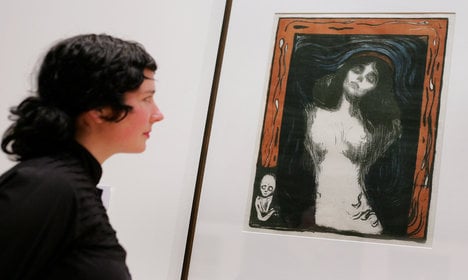The Divine Beauty show in Florence throws fresh light on religious art between the middle of the 19th and 20th centuries, with never-before seen together works in styles ranging from naturalism to symbolism, realism and abstract.
“When you think of sacred art you think of works of art up until the Baroque period at most,” which makes this exhibition particularly unusual, curator Ludovica Sebregondi told AFP.
It was Pope Pius IX (1792-1878) who encouraged this period of innovation in the arts: the Italian – a liberal first beloved then loathed by the people – was a fierce patron even during the most troubled period of his papacy.
The call to find a modern vocabulary for Christian art led to an explosion of new styles and in some cases total abandonment of classical depictions.
The most startling example here is Edvard Munch's half-body portraits of Mary – produced between 1895 to 1902 – in which she is shown nude, her expression described by the curators as “between erotic ecstasy and agony”.
In a second etching of the same work in the collection, the figure is framed by sperm, wriggling towards a foetus with a skeletal head, an echo of the figure in The Scream.
“The exhibition belies the idea that for 150 years faith was no longer interesting to artists,” Florence Archbishop Giuseppe Betori told journalists at the show's opening, saying the collection captured “lesser known aspects of modern art”.
Sacred theme becomes personal
It is a new sacred art: here the virtuosos, some of whom rarely painted religious works, used the Christian story to express personal tragedies or depict the horrors of the First and Second World Wars.
In 1964, where this exhibition ends, Pope Paul VI appealed for “the friendship between the Church and artists” to be “re-established” in a bid to return to tradition – but it was too late to undo some of history's most provocative works.
“Each one tells their own story. When the sacred theme is no longer tied to Church politics it really becomes a personal theme,” co-curator Anna Mazzanti said.
In one work, Munch explores the act of prayer: a 1902 woodcut depicts his father – “obsessively religious, almost to the point of psychosis” – kneeling with hands clasped, just as he had seen him once following a violent argument.
Nearby hangs an oil and charcoal on paper by Spain's Pablo Picasso, executed in 1896 when he was just 15, which shocked many critics who saw the depiction of a dog or wolf in the head of Christ – an act of blasphemy if that was indeed the artist's intention.
At the heart of the exhibition is Chagall's 1938 White Crucifixion, which Pope Francis has said is one of his favourite paintings, testifying to the fear and suffering of the Jews during the attacks on them throughout Nazi Germany during 'Kristallnacht' (Crystal Night).
Jesus is depicted on the cross, but his loincloth is replaced with a prayer shawl, his crown of thorns a headcloth, and while a Nazi sets fire to a synagogue nearby, refugees can be seen fleeing by boat – an echo of the modern migrants so close to Pope Francis's heart now fleeing warzones for Europe.
The exhibition, which features over 100 works, runs until January 24, 2016 at Florence's Strozzi Palace in the Tuscan city's historic centre.



 Please whitelist us to continue reading.
Please whitelist us to continue reading.
Member comments